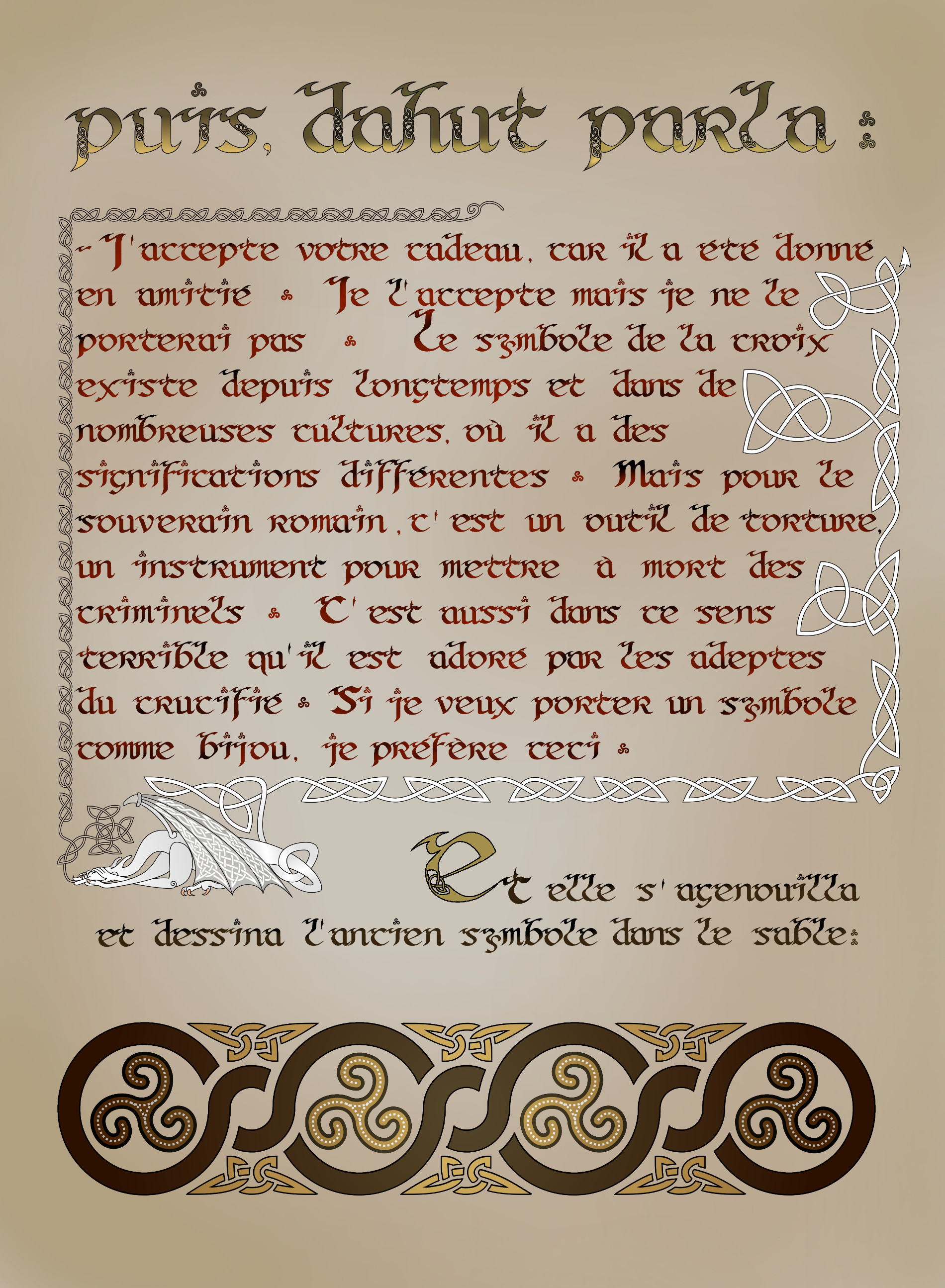fol. 12r
Puis, Dahut parla:
- J'accepte votre cadeau, car il a été donné en amitié.
Je l'accepte, mais je ne le porterai pas.
Le symbole de la croix existe depuis longtemps et dans de nombreuses cultures, où il a des significations différentes(1).
Mais pour le souverain romain, c'est un outil de torture, un instrument pour mettre à mort les criminels. C'est aussi dans ce sens terrible qu'il est adoré par les adeptes du crucifié(2) .
Si je veux porter un symbole comme bijou, je préfère ceci.
Et elle s'agenouilla et dessina l'ancien symbole dans le sable:
(1) Le pasteur écossais Alexander Hislop voulait prouver dans son livre "Les Deux Babylones" (1958 - version française en ligne ici: ) que le catholicisme est en fait d'origine un culte à mystère païen de Babylone (par opposition au protestantisme, qui adore le seul et unique Jésus et le seul et unique Dieu). Selon lui, le symbole de la croix provient de la lettre Tau, la première lettre du dieu babylonien Tammuz, et était un symbole du soleil. De là, ce symbole païen s'est répandu en Égypte (muté en croix d'Ankh, le symbole de la vie physique et éternelle), à Rome (les vierges vestales auraient porté une croix Tau autour du cou), chez les Celtes, où les druides taillaient de grands arbres cruciformes "comme symbole de leur divinité".
Au Mexique, de grandes croix de pierre ont été érigées en l'honneur du dieu de la pluie.
Les affirmations de Hislop ont souvent été reprises plus tard comme preuve de l'origine païenne babylonienne du symbole de la croix.
A propos de la croix celtique:
"Si la croix celtique est certainement un symbole chrétien, elle trouve également ses racines dans d'anciennes croyances païennes. Le cercle de pierres à Callanish, sur l'île de Lewis en Écosse, est construit en un cercle approximatif, avec une croix à bras égal. On pense que c'est un symbole du soleil pour les créateurs du cercle de pierres, qui est devenu une forme sacrée pour les Celtes.
Des relations évidentes peuvent également être dérivés de la forme, telles que l'est, le nord, le sud et l'ouest; ou la terre, l'air, l'eau et le feu. Même les Amérindiens l'ont utilisé comme symbole de leur roue médicinale. La roue solaire a également été appelée la croix d'Odin, un symbole de la mythologie nordique."
(Source: IrishFireside.com)
(2) À l'époque de la persécution des chrétiens par l'Empire romain, les chrétiens n'avaient pas une croix comme symbole, mais un poisson. Les lettres du mot grec "ichtus" signifient alors "Jésus-Christ, Fils de Dieu, Sauveur". On croyait que c'était un symbole "secret", qui ne serait pas reconnu par les non-chrétiens stupides ...
Ce n'est qu'au quatrième siècle, après l'installation de la liberté religieuse dans l'Empire romain par l'empereur Constantin, que la croix comme symbole a connu un progrès rapide, et que les chrétiens pouvaient l'adorer sans risquer d'y être posés eux-mêmes.
fol. 12r
Then, Dahut spoke:
- I accept your gift, because it was given in friendship.
I accept it, but I will not wear it.
The symbol of the cross has been around for a long time and in many cultures, where it has different meanings(1) .
But for the Roman sovereign, it is a tool of torture, an instrument to put criminals to death. It is also in this terrible sense that he is adored by the followers of the crucified(2) .
If I want to wear a symbol as a piece of jewelry, I prefer this.
And she knelt down and drew the ancient symbol in the sand:
(1) The Scottish Reverend Alexander Hislop wanted to prove in his book "The Two Babylons" (1958 - french on-line version here: ) that Catholicism is actually a pagan mystery cult from Babylon (as opposed to Protestantism, which does worship the one and only Jesus and the one and only God). According to him, the cross symbol stems from the letter Tau, first letter of the Babylonian god Tammuz, and was a sun symbol. From there this pagan symbol spread to Egypt (mutated into the Ankh cross, the symbol of physical and eternal life), Rome (the Vestal virgins are said to have worn a Tau cross around their necks), to the Celts, where the druids pruned large trees cross-shaped "in symbol of their divinity".
In Mexico, large stone crosses were erected in honor of the rain god.
Hislop's claims were often later retaken as evidence for the pagan Babylonian origin of the cross symbol.
About the Celtic cross:
"While the Celtic Cross is certainly a Christian symbol, it has its roots in ancient pagan beliefs at the same time. The stone circle at Calanais, on the Isle of Lewis in Scotland, is formed in a rough circle, with an even-armed cross within it. This is believed to be a sun symbol to the creators of the stone circle, which became a sacred shape to the Celts.
Obvious relations such as east, north, south and west; or earth, air, water and fire can also be derived from the shape. Even the Native Americans used this as a symbol for their Medicine Wheel. The sun wheel has also been called Odin’s Cross, a symbol in Norse Mythology."
(Source: IrishFireside.com)
(2) In the time of the persecution of Christians by the Roman Empire, the Christians did not have a cross as a symbol, but a fish. The letters of the Greek word "ichtus" then stand for "Jesus Christ, God's Son, Savior". It was considered to be a "secret" symbol, which would not be recognized by dumb non-Christians ...
It was not until the fourth century, after the installation of religious freedom in the Roman Empire by Emperor Constantine, that the cross as a symbol experienced rapid progress, and that Christians could worship it without risking to end on it themselves.
Cliquez l'image pour une meilleure qualité.
Click on the picture for a better quality.

